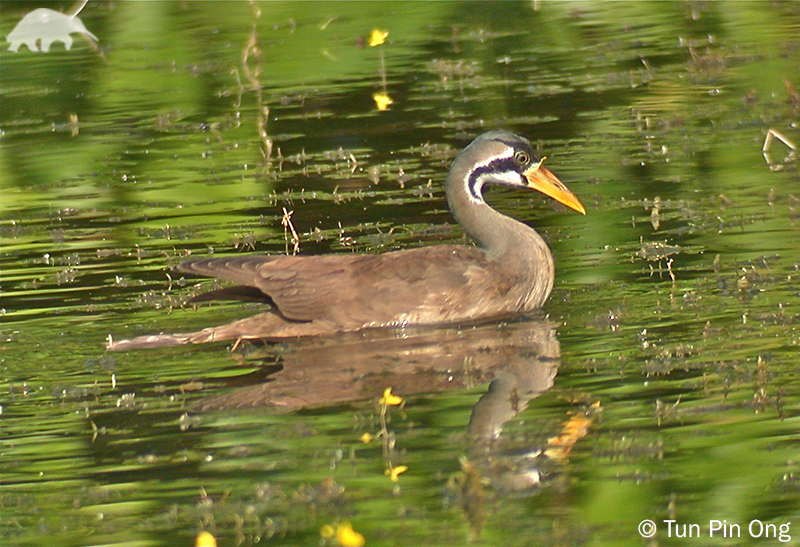At the brink of extinction: The iconic Masked Finfoot of Indo-Burma’s forested wetlands
Few species of waterbirds in the Indo-Burma region are as threatened as the highly distinct Masked Finfoot, currently listed as ‘Endangered’ on the IUCN Red List of Threatened Species and ranked 43 on the EDGE species list. A new study published in the journal, Forktail: Journal of Asian Ornithology involving researchers from the University of Cambridge, BirdLife International, Wildlife Conservation Society and Mahidol University, revealed a tiny, still declining global population of the Masked Finfoot. Available data compiled by the researchers found that the present population of the species may not exceed 304 adult individuals, a number far smaller than previously thought. The species is now likely to qualify as ‘Critically Endangered’ on the IUCN Red List of Threatened Species TM.

Photo: © Tun Ping Ong
The Masked Finfoot once occurred widely across the lowlands of Indo-Burma, south to the Malay Peninsula and Sumatra. As forested rivers in the Lower Mekong floodplains of Cambodia, Lao PDR, and Viet Nam become increasingly disturbed by riparian development and other unsustainable uses, the last populations of the finfoot are quickly disappearing.
Mr. Sayam Chowdhury, the paper’s lead author and a leading expert on the species noted that the Masked Finfoot may now only breed in Cambodia and Bangladesh. “Our assessment of the species across its global distribution is grim. We found no recent records in Thailand and Malaysia. Our data suggests that the finfoot is in greater danger of extinction than any other similarly sized waterbird.”
The small population of the Masked Finfoot, and the low density of the species means that it is especially vulnerable to man-made threats. Dr. Simon Mahood, senior technical advisor at the Wildlife Conservation Society in Cambodia and a co-author on the study observed that, “habitat loss and disturbance by people are clearly the most devastating threats to riverine bird species. Low-lying, forested wetlands across South-East Asia are now heavily encroached upon by human activities.”
Dr. Yong Ding Li, migratory bird coordinator for BirdLife International (Asia) and a co-author of the study noted that, “The small populations of the species, coupled with the lack of an ‘insurance’ captive breeding programme, means that the species now teeters on the brink of extinction. The Masked Finfoot should be uplisted to Critically Endangered to reflect the steep declines it has suffered and its small population.”
Mr. Jonathan Eames OBE, a co-author of the study and BirdLife’s senior adviser in Cambodia reminisced about his observations of the Masked Finfoot during his visits to Southeast Asia in the 1980s. “The are many, like me, who saw the finfoots at Taman Negara in Malaysia by wading neck deep and also with local expert, Mr. Dai who revealed the species to many in the mangroves of Krabi, Thailand. The species is truly an icon for the state of rivers of Southeast Asia.”
The authors make several recommendations, including limiting access to key Masked Finfoot sites during the breeding season, restricting use of mono-filament gillnets, and increased efforts to protect key lowland wetland areas. The sites in Bangladesh and Cambodia deserve the maximum possible protection. The authors also called for more surveys to relocate the species in northern Myanmar, when conditions allow, and develop an action plan to coordinate conservation actions.
About IBRRI
The Indo-Burma Ramsar Regional Initiative (IBRRI) was jointly developed by the Ramsar National Focal Points of the five countries (Cambodia, Lao PDR, Myanmar, Thailand, and Viet Nam), and IUCN’s Asia Regional Office, based on specific needs identified in these countries. It was endorsed by the 52nd meeting of the Ramsar Convention Standing Committee in June 2016. The IBRRI aims to support the coordinated implementation of the objectives of the Strategic Plan of the Ramsar Convention. IUCN acts as the Secretariat for the Initiative under the leadership of the Steering Committee, which includes representatives from the five governments and the Ramsar Convention Secretariat as an observer.
__________
For more information (including high resolution images), please contact:
Sayam U. Chowdhury, Sundarbans Finfoot Research Project, and University of Cambridge
Email: suc21@cam.ac.uk
Jonathan C. Eames OBE, BirdLife International Cambodia Programme
Email: Jonathan.Eames@birdlife.org
Philip D. Round, Mahidol University
Email: philip.rou@mahidol.ac.th
Robert Tizard, Wildlife Conservation Society Myanmar Program
Email: rjtizard@ocellata.com
Simon Mahood, Wildlife Conservation Society Cambodia Program
Email: smahood@wcs.org
Yong Ding Li, BirdLife International Asia Division
Email: dingli.yong@birdlife.org
EDGE species link:



